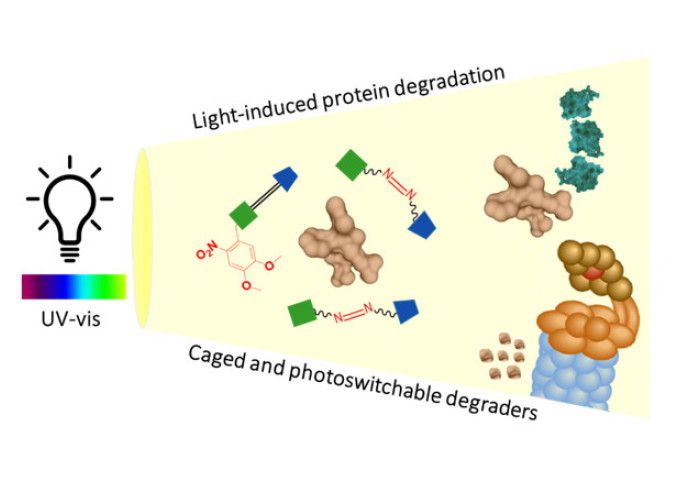

Congratulations to PhD student Cyrille Koundé on his publication reviewing Protein Targeting Chimeras (PROTACs)
PhD student Cyrille Koundé has recently published a miniperspective in the Journal of Medicinal Chemistry. The review summarizes the work of multiple research groups (including the Tate group) who have investigated light-dependent activation of bifunctional degraders also known as Proteolysis Targeting Chimeras (PROTACs).
PROTACs are heterobifunctional molecules which promote a non-physiological interaction between a target protein and an E3 ligase through the formation of a ternary complex, leading to ubiquitination and proteasomal degradation of the target protein. To achieve exquisite spatiotemporal control over the degradation process in cells, PROTACs have recently been modified with photolabile or photoswitchable moieties. Those novel tool compounds can trigger or halt protein degradation only upon irradiation with UV-visible light. The review carefully examines the design, properties, and applications of light-activated degraders and discusses the differences between two main approaches.
While PROTACs modified with caging groups are straightforward to devise and are activated readily, they can only “switch on” proteolysis. On the contrary, degraders bearing switchable motifs such as azobenzene offer an appealing bidirectional on/off mechanism allowing a reversible control over protein stability. Relevant examples highlighting the impact of such precision tools in chemical biology are presented in the article.
Finally, the review considers photoactive degraders from a medicinal chemistry and photopharmacology perspective describing the opportunities but also the challenges associated with the translation of light-dependent degradation into the field of precision medicine.
We would like to thank the Engineering and Physical Sciences Research Council (EPSRC) and GlaxoSmithKline Research and Development for funding Cyrille's work on the conditional activation of PROTACs.
Article text (excluding photos or graphics) © Imperial College London.
Photos and graphics subject to third party copyright used with permission or © Imperial College London.
Reporter
Dr Ravi Singh
Department of Chemistry

Contact details
Tel: +44 (0)20 7594 9222
Email: ravi.singh@imperial.ac.uk
Show all stories by this author



